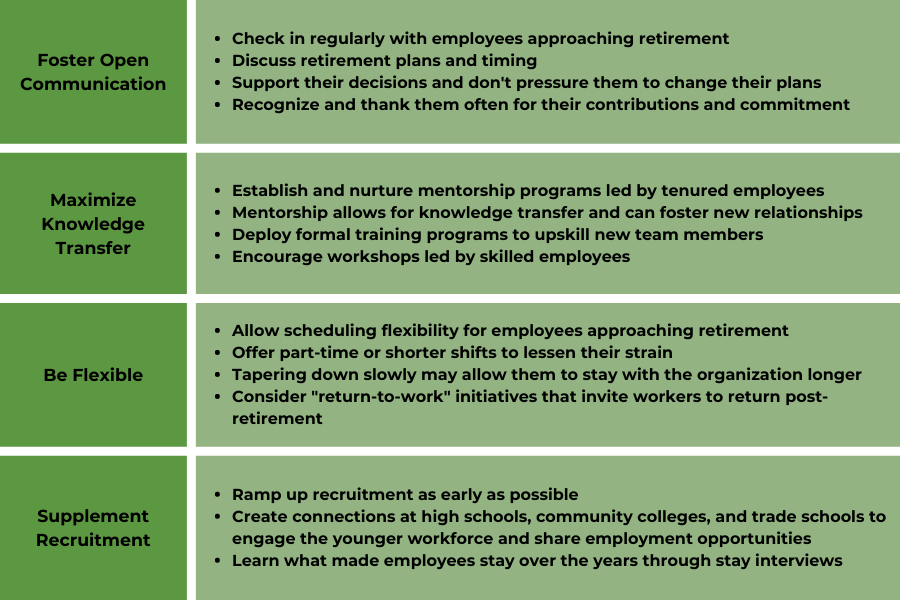The 'Great Retirement' and the Aging Workforce
It’s no secret that the Baby Boomer generation is quickly approaching retirement age. Have you thought about how you are going to manage an aging workforce in 2023 and the coming years?
Based on data from the Bureau of Labor Statistics, in 2021 sixty-one percent of the population ages 55 to 64 were employed and made up about 21% of the total workforce. For those 65 years and older, the employed percentage drops to 18% and represents only about 7% of the total workforce.
What does this mean? Well, the U.S. Census Bureau predicts that all Baby Boomers will be over the age of 65 by 2030. This group will make up more than 20 percent of U.S. residents and is projected to surpass the number of people under 18 for the first time in 2034. This means that organizations across the board will lose a chunk of employees to retirement in the next ten years and could have a hard time filling their positions with the younger generations. From 2011 to 2019, we saw an average of about two million people retire each year and then spike to 3.5 million in 2020, likely due to the pandemic. If this trend continues, what has been called the ‘Great Retirement’ can pose a threat to organizations already struggling with staffing levels and those relying on knowledge transfer from their senior employees.
We’ve put together four best practices for managing an aging workforce that you can mix into your strategy to help lower the impact you will feel as more of your people start to retire.

1) Foster Open Communication
Don’t shy away from the topic of retirement with your team. It is important to create open communication channels for all your people, especially those nearing retirement. Set up regular check-ins with employees so that there is more opportunity to discuss retirement plans. You want your people to feel comfortable sharing their thoughts and opinions with you. These conversations will help you quantify the number of people you might be losing and can help you plan your next steps. When having these conversations, make sure you are supporting their decisions and not pressuring them to change their plans. Be sure to recognize all that they have contributed to the organization and thank them for their commitment over the years.
2) Maximize Knowledge Transfer
If you are in an industry that relies on the sharing and transfer of knowledge from tenured employees, you’ll want to put practices in place to help retain as much of that knowledge as possible. A popular tactic is to establish mentorship programs where tenured employees can share skills, insights, and best practices with younger or new employees. Not only does mentorship help with knowledge transfer but also fosters new relationships and boosts engagement among teams.
Along with mentorship, consider implementing formal training programs. Consult with those nearing retirement to collect their thoughts and input on training tactics and subject matter. They likely know what areas need improvement and have gained specialized knowledge through experience. You could even have them host short training sessions or workshops if they are willing. Having employees learn hands-on from someone on their team is oftentimes much more effective than having them follow a generic video or training manual.
3) Be Flexible
As people approach retirement age, working full-time can put a lot of strain on them but they may not be ready to fully retire just yet. Meet employees where they are and create flexible work schedules for them so they can phase into retirement at their own pace. Avenues like part-time work, shorter shifts spread throughout the week, and slowly tapering their hours over the months can be appealing options. By providing extra flexibility, they may be willing to prolong their time with the organization and may even consider returning post-retirement. We’ve seen some organizations create “return-to-work” programs that encourage retired employees to come back for part-time, seasonal, or consulting positions. Rehiring these employees is usually a streamlined process because they don’t require the same onboarding process as a typical new hire and are familiar with the culture of the organization.
4) Supplement Recruitment
As you prepare for the ‘Great Retirement’, you’ll want to start ramping up your recruitment strategy. You don’t want to wait until there are many vacant positions to fill to solidify your tactics. Get creative with your efforts and explore options within your community. An underused avenue is creating connections at high schools, community colleges, and trade schools in the area. Depending on your industry, they could be a very useful pool of entry-level talent that could be upskilled and grow within your organization. Educating these students on the opportunities that you offer could spark their interest in a career path that they hadn’t previously considered.
Additionally, your tenured employees are the perfect resource for guiding recruitment efforts. Learning what made them stay over the years can point you to what can attract new prospects. Consider deploying stay interviews as an easy way to collect feedback and insights from your teams. Ask them questions about what factors they enjoy most about the organization and the work that they do. Once you have their thoughts, review them to see if there are any common themes that can help shape future recruitment efforts.
To Sum it Up:
The looming ‘Great Retirement’ can be daunting, but with the right tools in place, you can minimize the impact of losing employees to retirement. Being proactive in your communications with your aging workforce will paint a clear picture of the future and will help you plan accordingly. By focusing on retaining and transferring the knowledge they have gained over the years to fellow employees, you can lessen the impact of their departure. Be flexible with hours and work styles and leave the door open for them to return post-retirement. Build up your recruitment pipeline through partnerships with schools and trade programs in your community so that you’ll have a solid talent pool to supplement from. Most importantly, show appreciation and thank your employees as much as possible for being a part of your team!





